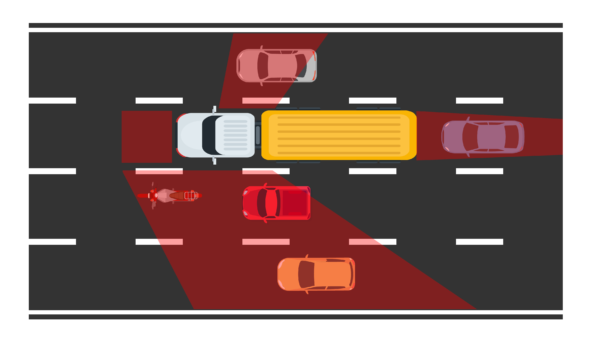How should you drive around large lorries?
Blind spots are the bane of a lorry driver’s life. It’s difficult to set mirrors in a way that eliminates all of them. Even with new HGV cameras, the view isn’t spectacular (but it is getting better all the time). As a car driver or motorbike rider, what safety precautions should you take when you drive around HGVs?
Assume the driver can’t see you
The elevated driving position in a truck only assists with forward view; it hinders the driver’s view right in front of the truck and next to the passenger door. Having multiple mirrors (one flat one facing down the side, one convex one covering the lane and one convex one pointing down to see the front wheel) is one way drivers accommodate these blind spots.

There’s a massive blind spot right behind the trailer or the rear of the lorry, and there are blind spots extending out diagonally backwards away from the lorry, meaning the driver often can’t see vehicles overtaking them. This is particularly problematic for small vehicles like cyclists and motorcyclists.
Don’t drive in the areas where the driver obviously can’t see you. If you can’t see the driver in one of the mirrors, it’s likely the driver can’t see you.
This means that if you have to pass through a blind spot, e.g. to overtake the lorry, do it quickly (don’t dawdle).
Anticipate what the driver will do
Most drivers give plenty of signals they are about to manoeuvre. These signals include using the actual indicators, braking and changing lane position.
A lorry has a wider turning circle than a car, so drivers will often have to swing out wide to get a trailer around a corner. Resist the urge to try to overtake them at this point or you might end up under the trailer.
Don’t deprive drivers of their safety bubble
Lorries have longer stopping distances and are less manoeuvrable than cars. Drivers will leave a larger gap in front of them as a braking safety bubble; don’t dive into this gap at the last minute otherwise you could cause them to run into the back of you.
Give good signals
If you do have to move into a gap, give the driver plenty of warning with your indicators and road position. Ensure you’re far enough ahead of the lorry so that the driver can see you (if the back of your car is level with the lorry’s front bumper, you’re in a blind spot.) Be predictable in your driving and don’t cause the driver to have to swerve suddenly.
- Understanding the National Standards for Riding Mopeds and Motorcycles
- Livestock Transport Rules UK: A Complete Guide to Animal Transportation Requirements
- The Role of Safety Advisers in Dangerous Goods Transport
- Sustainable Driving: Reducing Your Environmental Impact on the Road
- Developing Effective Lesson Plans for Driver Training
- UK Agricultural Vehicle Registration and Tax Relief
- Challenges of Transporting Radioactive Materials (Class 7)
- Exemptions and support for Clean Air Zone charges
- Navigating Legal Requirements: The UK Motorcycle Licensing Rules
- Safe Transportation of Agricultural Chemicals and Hazardous Materials
- Innovations in Vehicle Construction for ADR Compliance
- Motorcycle Recovery Operations: How to Recovery a Broken Down Motorbike
- Alternative Fuels in Agricultural Vehicles
- Carriage of Dangerous Solids in Bulk Containers
- Understanding Limited Quantity Exemptions in ADR